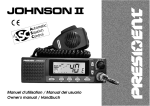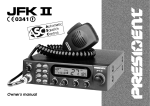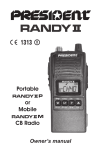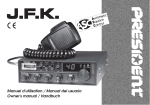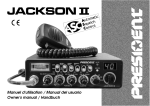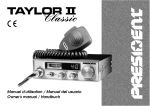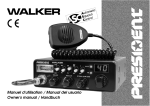Download PRESIDENT JOHNNY III Owner`s manual
Transcript
Manuel d’utilisation / Manual del usuario Owner’s manual / Instrukcja obsługi Votre PRESIDENT JOHNNY III ASC en un coup d’œil Your PRESIDENT JOHNNY III ASC at a glance Un vistazo a vuestro PRESIDENT JOHNNY III ASC Twój PRESIDENT JOHNNY III ASC SOMMAIRE INSTALLATION UTILISATION CARACTÉRISTIQUES TECHNIQUES GUIDE DE DÉPANNAGE COMMENT ÉMETTRE/RECEVOIR UN MESSAGE GLOSSAIRE GARANTIE DÉCLARATION DE CONFORMITÉ TABLEAUX DES FRÉQUENCES NORMES EUROPÉENNES SUMMARY INSTALLATION HOW TO USE YOUR CB TECHNICAL CHARACTERISTICS TROUBLE SHOOTING HOW TO TRANSMIT OR RECEIVE A MESSAGE GLOSSARY CERTIFICATE OF CONFORMITY FREQUENCY TABLES EUROPEAN NORMS is França SUMARIO INSTALACIÓN UTILIZACIÓN CARACTERÍSTICAS TÉCNICAS GUÍA DE PROBLEMAS COMO EMITIR O RECIBIR UN MENSAJE LÉXICO GARANTÍA DECLARACIÓN CE DE CONFORMIDAD TABLAS DE FRECUENCIAS NORMAS EUROPEAS 5 7 10 11 11 11 14 28 51 ~ 52 53 SPIS TREŚCI English INSTALOWANIE UŻYTKOWANIE RADIOTELEFONU DANE TECHNICZNE INSTRUKCJA POSTĘPOWANIA W PRZYPADKU PROBLEMÓW Z RADIEM JAK NADAWAĆ I ODBIERAĆ INFORMACJE SŁOWNIK ZOBOWIĄZANIA GWARANTA DEKLARACJA ZGODNOŚCI TABELA CZĘSTOTLIWOŚCI NORMY EUROPEJSKIE 31 33 36 37 37 37 39 51 ~ 52 53 3 ol Españ 17 19 23 23 23 24 26 29 51 ~ 52 53 Polski 41 43 47 47 47 48 48 50 51 ~ 52 53 WARNING ! Before using, be careful never to transmit without first having connected the antenna (connection «B» situated on the back panel of the equipment) or without having set the SWR (Standing Wave Ratio) ! Failure to do so may result in destruction of the power amplifier, which is not covered by the guarantee. English MULTI-NORMS TRANSCEIVER! See function “F” on page 34 and the Configuration table on page 53. The garantee of this transceiver is valid only in the country pf purchase. 30 Welcome to the world of the new generation of CB radios. The new PRESIDENT range gives you access to top performance CB equipment. With the use of up-to-date technology, which guarantees unprecedented quality, your PRESIDENT JOHNNY III ASC is a new step in personal communication and is the surest choice for the most demanding of professional CB radio users. To ensure that you make the most of all its capacities, we advise you to read carefully this manual before installing and using your PRESIDENT JOHNNY III ASC. A) INSTALLATION a) You should choose the most appropriate setting from a simple and practical point of view. b) Your CB radio should not interfere with the driver or the passengers. c) Remember to provide for the passing and protection of different wires (e.g. power, antenna, accessory cabling) so that they do not in any way interfere with the driving of the vehicle. d) To install your equipment, use the cradle (1) and the self-tapping screws (2) provided (drilling diameter 3.2 mm). Take care not to damage the vehicle’s electrical system while drilling the dash board. e) Do not forget to insert the rubber joints (3) between the CB and its support as these have a shock-absorbing effect which permits gentle orientation and tightening of the set. f) Choose where to place the microphone support and remember that the microphone cord must stretch to the driver without interfering with the controls of the vehicle. - N.B. : As the transceiver has a frontal microphone socket, it can be set into the dash board. In this case, you will need to add an external loud speaker to improve the sound quality of communications (connector EXT.SP situated on the back panel: D). Ask your dealer for advice on mounting your CB radio. MOUNTING DIAGRAM 31 English 1) WHERE AND HOW TO MOUNT YOUR MOBILE CB RADIO 2) ANTENNA INSTALLATION 3) POWER CONNECTION Your PRESIDENT JOHNNY III ASC is protected against an inversion of polarities. However, before switching it on, you are advised to check all the connections. Your equipment must be supplied with a continued current of 12 volts (A). Today, most cars and lorries are negative earth. You can check this by making sure that the negative terminal of the battery is connected either to the engine block or to the chassis. If this is not the case, you should consult your dealer. a) Choosing your antenna: - For CB radios, the longer the antenna, the better its results. Your dealer will be able to help you with your choice of antenna. b) Mobile antenna: - - English - Must be fixed to the vehicle where there is a maximum of metallic surface (ground plane), away from windscreen mountings. If you already have a radio-telephone antenna installed, the CB antenna should be higher than this. There are two types of antenna: pre-regulated which should be used on a good ground plane (e.g. car roof or lid of the boot), and adjustable which offer a much larger range and can be used on a smaller ground plane (see § 5, Adjustment of SWR). For an antenna which must be fixed by drilling, you will need a good contact between the antenna and the ground plane. To obtain this, you should lightly scratch the surface where the screw and tightening star are to be placed. Be careful not to pinch or flatten the coaxial cable (as this runs the risk of break down and/or short circuiting). Connect the antenna (B). WARNING: Lorries generally have two batteries and an electrical installation of 24 volts, in which case it will be necessary to insert a 24/12 volt converter (type CV 24/12 PRESIDENT) into the electrical circuit. The following connection steps should be carried out with the power cable disconnected from the set. a) Check that the battery is of 12 volts. b) Locate the positive and negative terminals of the battery (+ is red and - is black). Should it be necessary to lengthen the power cable, you should use the same or a superior type of cable. c) It is necessary to connect your CB to a permanent (+) and (-). We advise you to connect the power cable directly to the battery (as the connection of the CB cable to the wiring of the car-radio or other parts of the electrical circuit may, in some cases, increase the likelihood of interference). d) Connect the red wire (+) to the positive terminal of the battery and the black (-) wire to the negative terminal of the battery. e) Connect the power cable to your CB radio. c) Fixed antenna: - A fixed antenna should be installed in a clear a space as possible. If it is fixed to a mast, it will perhaps be necessary to stay it, according to the laws in force (you should seek professional advice). All PRESIDENT antennas and accessories are designed to give maximum efficiency to each CB radio within the range. WARNING: Never replace the original fuse (2 A) by one of a different value. OUTPUT RADIUS PATTERN 32 WARNING: In order to avoid any losses and attenuations in cables used for connection between the radio and its accessories, PRESIDENT recommends to use a cable with a length inferior to 3m. 4) BASIC OPERATIONS TO BE CARRIED OUT BEFORE USING YOUR SET FOR THE FIRST TIME (without transmitting and without using the «push-to-talk» switch on the microphone) Your CB is now ready for use. Connect the microphone Check the antenna connections Turn the set on by turning the volume knob (1) clockwise. Turn the squelch SQ knob (2) to minimum (M position). Adjust the volume to a comfortable level. Go to channel 20 by using the rotary knob (5). B) HOW TO USE YOUR CB 1) ON/OFF – VOLUME a) To turn the set on, turn the knob (1) clockwise. b) To increase the sound level, turn the same knob further clockwise. 5) ADJUSTMENT OF SWR (Standing wave ratio) WARNING: This must be carried out when you use your CB radio for the first time (and whenever you re-position your antenna). The adjustment must be carried out in an obstacle-free area. 2) ASC (Automatic Squelch Control) / SQUELCH Suppresses undesirable background noises when there is no communication. Squelch does not affect neither sound nor transmission power, but allows a considerable improvement in listening comfort. * Adjustment with external SWR-meter (e.g. TOS-1 PRESIDENT) a) To connect the SWR meter : - Connect the SWR meter between the CB radio and the antenna as close as possible to the CB (use a maximum of 40 cm cable, type President CA 2C). b) To adjust the SWR meter: - Set the CB to channel 20. - put the switch on the SWR-meter to position CAL (calibration). - Press the «push-to-talk» switch on the microphone to transmit. - Bring the index needle to W by using the calibration key. - Change the switch to position SWR (reading of the SWR level). The reading on the Meter should be as near as possible to 1. If this is not the case, re-adjust your antenna to obtain a reading as close as possible to 1. (An SWR reading between 1 and 1.8 is acceptable). - It will be necessary to re-calibrate the SWR meter after each adjustment of the antenna. a) ASC: AUTOMATIC SQUELCH CONTROL Worldwide patent, a PRESIDENT exclusivity. Turn the SQ knob (2) anti-clockwise into ASC position. «ASC» appears on the display. No repetitive manual adjustment and a permanent improvement between the sensitivity and the listening comfort when ASC is active. This function can be disconnected by turning the switch clockwise. In this case the squelch adjustment becomes manual again. «ASC» disappears from the display. b) MANUAL SQUELCH Turn the SQ knob clockwise to the exact point where all background noise disappears. This adjustment should be done with precision as, if set to maximum (fully clockwise), only the strongest signals will be received. 33 English a) b) c) d) e) f) Proceeding: switch off the transceiver. Keep the key F pressed and switch on again. 3) DISPLAY It shows all functions: - and the letter corresponding to the configuration are blinking. In order to change the configuration, use the channel selector on the front panel. When the configuration is selected, press 1 second on the F key. and the letter corresponding to the configuration are continuously displayed, a beep sounds. At this point, confirm the selection by switching off the transceiver and then switching it on again. See table page 53. The BARGRAPH shows the reception level and the output power level. KEY BP Beep on changing the channel, keys etc... (long press) Activate the KEY BP function by pressing 1 second the KEY BP key. A beep sounds and «BP» is displayed. In order to disable the function, press during 1 second the KEY BP key. «BP» disappears. 4) RF GAIN Adjustment of the sensitivity during reception. For long distance communications RF GAIN should be set to maximum. You can reduce the RF GAIN in order to avoid distortion when your correspondent is close by and when he has no RF POWER. 7) VOX ~ VOX SET The normal setting of this function is on maximum (fully clockwise). English VOX (short press) 5) CHANNEL SELECTOR: Rotary Knob The VOX function allows transmitting by speaking into the original microphone (or in the optional vox microphone) without pressing the PTT switch. The use of an optional vox mike connected to the rear panel of the transceiver (C) disables the original microphone. Press shortly the VOX key in order to activate the VOX function. «VOX» appears on the display. A new press on the VOX key disables the function «VOX» disappears. This button allow increasing or decreasing a channel. A «beep» sounds each time the channel changes if the KEY BP function is activated. See KEY BP function. 6) F ~ KEY BP F - FREQUENCY BAND SELECTION VOX SET (long press) (configuration: E; d; EU; PL) The frequency bands have to be chosen according to the country of use. Don’t use any other configuration. Some countries need a user’s licence. See the configurations/ frequency bands table at page 53. Press during 1 second the VOX key in order to activate the functionVox adjustment. Three adjustments are possible: Sensitivity / Anti-vox level / Vox delay time . Press shortly the VOX key in order to go to the following adjustment (looping , , ). The display shows the type of adjustment followed by its level. 34 Sensitivity : allows the adjustment of the microphone (original one or optional vox) for an optimum transmission quality. Adjustable level from 1 (high level) to 9 (low level) by rotating the channel knob. corresponds to the Sensitivity Level. - Anti-Vox : allows disabling the transmission generated by the surrounding noise. The level is adjustable from 0 (Off) to 9 (low level) by rotating the channel knob. corresponds to Anti-vox Level. - Delay time : allows avoiding the sudden cut of the transmission by adding a delay at the end of speaking. The level is adjustable from 1 (short delay) to 9 (long delay) by rotating the channel selector. corresponds to Delay Time. respondent that it was his turn to talk. The word “Roger” has been replaced by a significant beep. There comes “Roger beep” from. Note: the Roger beep also sounds in the loudspeaker if the KEY BP function is active. If the KEY BP function is not active, only the correspondent can hear the Roger Beep. SCAN (long press) Channel research: Allows activating the SCAN function (research of the channels) in an increasing way. «SCN» is displayed. The scanning stops as soon as there is a busy channel. The scanning automatically starts 3 seconds after the end of the transmission and no key is activated during 3 s. The scanning starts again in an increasing way by turning the rotary knob to the right, or in a decreasing way by turning the rotary knob to the left. Once the adjustments are done, press during 1 second the VOX key in order to quit the Vox Adjustment mode. A new long press on SCAN disables the SCAN function. 8) HI-CUT 10) STORE ~ MEM STORE (long press) Eliminates high frequency interferences. Has to be used in accordance with the reception conditions. A short press activates the HI-Cut filter and «HIC» appears on the display. A new press disables the function and «HIC» disappears. Allows to memorize an emergency channel with following parameters: ANL; HI-CUT. ANL FILTER (Automatic Noise Limiter) - The transceiver is equipped with an automatic filter which reduces back ground noises and some reception interferences in AM. - 9) ROGER ~ SCAN ROGER (short press) The icon « » appears on the display when the function is active. The Roger Beep sounds when the PTT switch of the microphone is released in order to let your correspondent speak. Historically as CB is a «simplex» communication mode, it is not possible to speak and to listen at the same time (as it is the case with a telephone). Once someone had finished talking, he said “Roger” in order to prevent his cor- To memorize: Select the channel to be memorized. press 1 second the MEM key; «MEM» appears in the display. If the KEY BP function is activated a long beep confirms the saving. To delete a memory: switch off the transceiver. keep the MEM key pressed and switch on the transceiver. the memory is deleted. MEM (short press) - 35 To recall a memory: press MEM shortly, «MEM» appears on the display. If the KEY BP function is activated a beep sounds. The memorized channel is actived. English - 11) LOCK C) TECHNICAL CHARACTERISTICS Allows to lock all the keys on the front panel and the rotary knob. An error beep sounds when a key is used and the LOCK function is activated. A short press on LOCK activates/deactivates the LOCK function. appears on the display when the function is activated. Transmission (mike or vox) and reception remain active. 1) GENERAL The plug is located on the front panel of the transceiver and makes the setting of the equipment into the dashboard easier. - See cabling diagram page 52. - Filter 12) 6 PIN MICROPHONE PLUG Channels Modulation modes Frequency ranges Antenna impedance Power supply Dimensions (in mm) Weight Accessories supplied 40 AM from 26.965 MHz to 27.405 MHz 50 ohms 13.2 V 125 (L) x 150 (H) x 45 (D) ~ 0.7 kg Electret microphone with support, mounting cradle, screws. : ANL (Automatic Noise Limiter) built-in 2) TRANSMISSION 13) PTT B) ANTENNA CONNECTOR (SO-239) - C) JACK FOR OPTIONAL VOX MIKE (Ø 2.5 mm) 3) RECEPTION Transmission key, press to transmit a message, to an incoming communication. : : : : : : : : is displayed and release to listen English A) DC-POWER TERMINAL (13,2 V) - D) EXTERNAL SPEAKER JACK (8 Ω, Ø 3,5 mm) Frequency allowance Carrier power Transmission interference Audio response Emitted power in the adj. channel Microphone sensitivity Drain Modulated signal distortion Maxi. sensitivity at 20 dB sinad Frequency response Adjacent channel selectivity Maximum audio power Squelch sensitivity - Frequency image rejection rate - Intermediate frequency rej. rate - Drain 36 : : : : : : : : : : : : : +/- 200 Hz 1 W AM inferior to 4 nW (- 54 dBm) 300 Hz to 3 KHz inferior to 20 µW 7 mV 1,7 A (with modulation) 1,8 % 0.5 µV - 113 dBm 300 Hz to 3 kHz 60 dB 2W minimum 0.2 µV - 120 dBm maximum 1 mV - 47 dBm : 60 dB : 70 dB : 300 mA nominal / 750 mA maximum your signal. Release the switch and wait for a reply. You should receive a reply like, «Strong and clear». If you use a calling channel (19, 27) and you have established communication with someone, it is common practice to choose another available channel so as not to block the calling channel. D) TROUBLE SHOOTING 1) YOUR CB RADIO WILL NOT TRANSMIT OR YOUR TRANSMISSION IS OF POOR QUALITY Check that the antenna is correctly connected and that the SWR is properly adjusted. Check that the microphone is properly plugged in. Check that the programmed configuration is the correct one (see table page 53). F) GLOSSARY Below you will find some of the most frequently used CB radio expressions. Remember this is meant for fun and that you are by no means obliged to use them. In an emergency, you should be as clear as possible. 2) YOUR CB RADIO WILL NOT RECEIVE OR RECEPTION IS POOR - Check that RF GAIN (4) is on maximum. Check that the squelch level is properly adjusted. Check that the programmed configuration is the correct one (see table page 53). Check that the volume is set to a comfortable listening level. Check that the microphone is properly plugged in. Check that the antenna is correctly connected and that the SWR is properly adjusted. INTERNATIONAL PHONETIC ALPHABET A B C D E F G 3) YOUR CB WILL NOT LIGHT UP - Check the power supply. Check the connection wiring. Check the fuse. Alpha Bravo Charlie Delta Echo Foxtrott Golf H I J K L M N Hotel India Juliett Kilo Lima Mike November O P Q R S T U Oscar Papa Quebec Romeo Sierra Tango Uniform TECHNICAL VOCABULARY E) HOW TO TRANSMIT OR RECEIVE A MESSAGE AM CB CH CW DX DW Now that you have read the manual, make sure that your CB Radio is ready for use (i.e. check that your antenna is connected). Choose your channel (19, 27). Press the «push-to-talk» switch and announce your message «Attention stations, transmission testing» which will allow you to check the clearness and the power of 37 : : : : : : Amplitude Modulation Citizen’s Band Channel Continuous Wave Long Distance Liaison Dual Watch V W X Y Z Victor Whiskey X-ray Yankee Zulu English - FM GMT HF LF : LSB RX SSB SWR SWL SW TX : UHF USB VHF Clean and green Cleaner channel Coming in loud and proud Doughnut Down and gone Down one Do you copy? DX : Eighty eights Eye ball Good buddy Hammer Handle Harvey wall banger How am I hitting you? Keying the mike Kojac with a kodak Land line Lunch box Man with a gun Mayday Meat wagon Midnight shopper Modulation Negative copy Over your shoulder Part your hair Pull your hammer back Rat race Rubberbander Sail boat fuel : Frequency Modulation : Greenwich Meantime : High Frequency Low Frequency : Lower Side Band : Receiver : Single Side Band : Standing Wave Ratio : Short Wave Listening : Short Wave CB Transceiver : Ultra High Frequency : Upper Side Band : Very High Frequency CB LANGUAGE English Advertising Back off Basement Base station Bear Bear bite Bear cage Big slab Big 10-4 Bleeding transmission Blocking the channel Blue boys Break Breaker : : : : : : : : : : Flashing lights of police car Slow down Channel 1 A CB set in fixed location Policeman Speeding fine Police station Motorway Absolutely Signal from an adjacent channel interfering with the : : : : Pressing the PTT switch without talking Police Used to ask permission to join a conversation A CBer wishing to join a channel 38 : Clear of police : Channel with less interference : Good reception : Tyre : Turning CB off : Go to a lower channel : Understand? Long distance : Love and kisses : CBers meeting together : Fellow CBer : Accelerator : CBer’s nickname : Dangerous driver : How are you receiving me? : Pressing the PTT switch without talking : Police radar : Telephone : CB set : Police radar : SOS : Ambulance : Thief : Conversation : No reply : Right behind you : Behave yourself - police ahead : Slow down : Congested traffic : New CBer : Wind : : : : : : : : Parked police car Police radar Interchange Antenna Dumb CBer Go up one channel All over/everywhere Please give me an S-meter reading CERTIFICATE OF CONFORMITY We, GROUPE PRESIDENT ELECTRONICS, Route de Sète, BP 100 – 34540 Balaruc – FRANCE, declare, on our own responsibility that the CB radio-communication transceiver Brand : PRESIDENT Model : JOHNNY III Manufactured in PRC is in conformity with the essential requirements of the Directive 1999/5/CE (Article 3) adapted to the national law, as well as with the following European Standards: EN 300 433-1 V1.1.3 (2000-12) EN 300 433-2 V1.1.2 (2000-12) EN 301 489-1 V1.7.1 (2007-4) EN 301 489-13 V1.2.1 (2002-8) EN 60215 ( 1996) Balaruc, the 2009-06-15 Jean-Gilbert MULLER General Manager 39 English Smokey dozing Smokey with a camera Spaghetti bowl Stinger Turkey Up one Wall to wall What am I putting to you? TABLEAU DES FRÉQUENCES pour EU / E / d TABLA DE FRECUENCIAS para EU / E / d FREQUENCY TABLE for EU / E /d TABELA CZĘSTOTLIWOŚCI DLA EU / E / d 51 N° du canal Nº Canal Channel Kanał Fréquences Frecuencia Frequency Częstotliwość N° du canal Nº Canal Channel Kanał Fréquences Frecuencia Frequency Częstotliwość 1 2 3 4 5 6 7 8 9 10 11 12 13 14 15 16 17 18 19 20 26,965 MHz 26,975 MHz 26,985 MHz 27,005 MHz 27,015 MHz 27,025 MHz 27,035 MHz 27,055 MHz 27,065 MHz 27,075 MHz 27,085 MHz 27,105 MHz 27,115 MHz 27,125 MHz 27,135 MHz 27,155 MHz 27,165 MHz 27,175 MHz 27,185 MHz 27,205 MHz 21 22 23 24 25 26 27 28 29 30 31 32 33 34 35 36 37 38 39 40 27,215 MHz 27,225 MHz 27,255 MHz 27,235 MHz 27,245 MHz 27,265 MHz 27,275 MHz 27,285 MHz 27,295 MHz 27,305 MHz 27,315 MHz 27,325 MHz 27,335 MHz 27,345 MHz 27,355 MHz 27,365 MHz 27,375 MHz 27,385 MHz 27,395 MHz 27,405 MHz TABLEAU DES FRÉQUENCES pour PL TABLA DE FRECUENCIAS para PL FREQUENCY TABLE for PL TABELA CZĘSTOTLIWOŚCI DLA PL PRISE MICRO 6 BROCHES CONEXIÓN DEL MICRO 6 PINS 6-PIN MICROPHONE PLUG WTYK MIKROFONU 6-PIN N° du canal Nº Canal Channel Kanał Fréquences Frecuencia Frequency Częstotliwość N° du canal Nº Canal Channel Kanał Fréquences Frecuencia Frequency Częstotliwość 1 2 3 4 5 6 7 8 9 10 11 12 13 14 15 16 17 18 19 20 26,960 26,970 26,980 27,000 27,010 27,020 27,030 27,050 27,060 27,070 27,080 27,100 27,110 27,120 27,130 27,150 27,160 27,170 27,180 27,200 21 22 23 24 25 26 27 28 29 30 31 32 33 34 35 36 37 38 39 40 27,210 27,220 27,250 27,230 27,240 27,260 27,270 27,280 27,290 27,300 27,310 27,320 27,330 27,340 27,350 27,360 27,370 27,380 27,390 27,400 52 1 Modulation Modulación Modulation Modulacja 2 RX RX RX RX 3 TX TX TX TX 4- - - - 5 Masse Masa Ground Masa 6 Alimentation Alimentación Power Supply Zasilanie NORMES EUROPÉENNES - NORMAS EUROPEAS - EUROPEAN NORMS - NORMY EUROPEJSKIE La bande de fréquence et la puissance d’émission de votre appareil doivent correspondre à la configuration autorisée dans le pays où il est utilisé. La banda de frecuencias y la potencia de emisión de su aparato deben corresponder a la configuración autorizada en el país donde él es utilizado. The frequency band and the transmission power of your transceiver must correspond with the configuration authorized in the country where it is used. Częstotliwość oraz moc nadawania Twojego radiotelefonu musi być zgodna z wymaganiami kraju, w którym jest on używany. 53 54 0962/05-09 SIEGE SOCIAL/HEAD OFFICE - FRANCE - Route de Sète - BP 100 - 34540 BALARUC Site Internet : http://www.president-electronics.com UTZZ01379BZ(0) E-mail : [email protected]





















